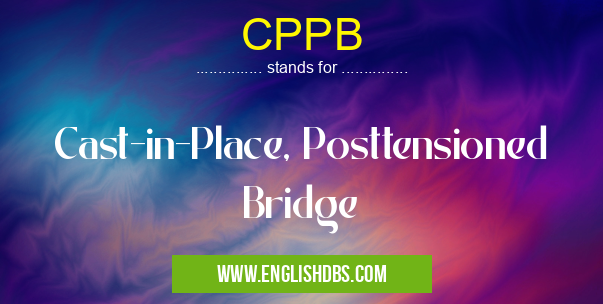What does CPPB mean in ENGINEERING
CPPB (Cast-in-Place, Posttensioned Bridge) is a type of bridge construction method widely used in modern bridge engineering. It involves casting concrete segments on-site and post-tensioning them together to form a continuous structure. This technique offers numerous advantages over traditional bridge construction methods, such as enhanced structural integrity, durability, and cost-effectiveness.

CPPB meaning in Engineering in Academic & Science
CPPB mostly used in an acronym Engineering in Category Academic & Science that means Cast-in-Place, Posttensioned Bridge
Shorthand: CPPB,
Full Form: Cast-in-Place, Posttensioned Bridge
For more information of "Cast-in-Place, Posttensioned Bridge", see the section below.
Key Features of CPPB
-
Casting Individual Segments:
- Concrete segments are cast separately on-site using specialized molds.
- These segments vary in size and shape depending on the bridge design.
-
Post-Tensioning:
- After the segments are cast, they are post-tensioned together using high-strength steel cables.
- This process involves applying tension to the cables, which compresses the segments, creating a continuous and rigid structure.
-
Continuous Structure:
- The post-tensioning process creates a continuous structure that distributes loads more efficiently than bridges with expansion joints.
- This eliminates joint maintenance issues and provides smoother traffic flow.
Advantages of CPPB
- Enhanced Structural Integrity:
- Post-tensioning creates a strong and durable structure that can withstand heavy loads and seismic activity.
- Durability:
- The absence of expansion joints reduces the risk of corrosion and deterioration, extending the bridge's lifespan.
- Cost-Effectiveness:
- CPPB can be more cost-effective than traditional methods due to reduced maintenance costs and longer service life.
- Aesthetic Appeal:
- CPPB bridges can be designed to enhance the aesthetics of the surrounding environment.
Essential Questions and Answers on Cast-in-Place, Posttensioned Bridge in "SCIENCE»ENGINEERING"
What is a CPPB (Cast-in-Place, Posttensioned Bridge)?
A CPPB is a type of bridge constructed by casting concrete at the construction site and then applying post-tensioning to enhance its structural integrity.
How is a CPPB different from a conventional concrete bridge?
In a CPPB, the concrete is post-tensioned after it has been cast, which significantly increases its strength and durability compared to conventional concrete bridges.
What are the advantages of using a CPPB?
CPPBs offer several advantages, including:
- Increased strength and durability due to post-tensioning.
- Longer lifespan compared to conventional concrete bridges.
- Reduced construction time due to prefabrication and off-site casting.
- Improved seismic resistance and load-bearing capacity.
- Aesthetically pleasing designs with exposed concrete surfaces.
What are the applications of CPPBs?
CPPBs are commonly used in various applications, such as:
- Highway overpasses and interchanges.
- Pedestrian and bicycle bridges.
- Bridges over rivers, canals, and waterways.
- Viaducts and elevated roadways.
How is a CPPB constructed?
CPPB construction typically involves the following steps:
- Designing and fabricating the bridge components.
- Casting the concrete elements at an off-site facility.
- Transporting the precast elements to the construction site.
- Erecting the bridge components and connecting them.
- Post-tensioning the concrete to enhance its strength.
What are the key considerations in designing a CPPB?
Critical considerations in designing a CPPB include:
- Structural loads and forces.
- Seismic and wind resistance.
- Material properties and durability.
- Aesthetics and architectural requirements.
- Environmental and sustainability factors.
Final Words: CPPB is an innovative bridge construction method that offers significant advantages in terms of structural integrity, durability, cost-effectiveness, and aesthetics. By casting concrete segments on-site and post-tensioning them together, CPPB creates continuous structures that can withstand the demands of modern traffic. This technique has gained widespread acceptance in the bridge engineering industry and is expected to continue playing a vital role in the construction of future bridges.
